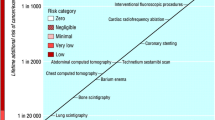Abstract
This paper uses chronic beryllium disease as a case study to explore some of the challenges for decision-making and some of the problems for obtaining meaningful informed consent when the interpretation of screening results is complicated by their probabilistic nature and is clouded by empirical uncertainty. Although avoidance of further beryllium exposure might seem prudent for any individual whose test results suggest heightened disease risk, we will argue that such a clinical precautionary approach is likely to be a mistake. Instead, advice on the interpretation of screening results must focus not on risk per se, but on avoidable risk, and must be carefully tailored to the individual. These points are of importance for individual decision-making, for informed consent, and for occupational health.

Similar content being viewed by others
Notes
We would like to thank the Center for Bioethics at the University of Pennsylvania for inviting Mark Greene to serve as a Visiting Scholar and for stimulating the work on this paper. Thanks also to John Philpott, David Philpott, and anonymous reviewers for very helpful comments. We especially wish to acknowledge the invaluable research contributions of Heidi Fisher and Nicholas Slack.
The U.S. Department of Energy identified sample analysis costs in a range up to a few hundred dollars in its 1999 assessment of the economic impact of its CBD prevention rule [8].
The BeLPT is performed on a simple venous blood draw. Alternatives such as bronchial lavage lymphocyte proliferation testing or lung biopsy and more invasive. Also, in contrast to beryllium skin testing, which raises concerns about inducing a sensitivity to beryllium that was not present prior to testing, BeLPT does not challenge the individual being tested with beryllium [1].
Translation by Mark Greene.
CBD is managed with corticosteroids, which carry significant side effects.
Relevant assumptions are tabulated, with their empirical justifications, on p. 1213 with graphs of the curves on p. 1214, and further discussion of the limitations of the assumptions on pp. 1218–1219 [4].
Notation altered.
The whole population P max(CBD) is 0.04 which is 0.04/0.06 = 0.67 of the BeLPT+ sub population.
See also [4].
This accords with Judd and colleagues’ finding that BeLPT screening is most cost effective in the early years of beryllium employment [4].
Related issues are discussed in greater detail in [4]. Even measures that technically reduce CBD prevalence in the population of beryllium workers and former workers might increase the number of cases by increasing the exposed population with higher worker turnover.
References
Poulin, Maurice, and Sylvie Ricard. 2004. Le test sanguin de prolifération lymphocytaire au béryllium (belpt). Québec: Institut National de Santé Publique du Québec.
Marchand-Adam, S., F. Guillon, M. Brauner, and D. Valeyre. 2005. Bérylliose pulmonaire chronique (2e partie). Revue des Maladies Respiratoires 22: 271–287.
Newman, Lee S., Margaret M. Mroz, Ronald Balkissoon, and Lisa A. Maier. 2005. Beryllium sensitization progresses to chronic beryllium disease: A longitudinal study of disease risk. American Journal of Respiratory and Critical Care Medicine 171: 54–60.
Judd, Nancy L., William C. Griffith, Tim Takaro, and Elaine M. Faustman. 2003. A model for optimization of biomarker testing frequency to minimize disease and cost: Example of beryllium sensitization testing. Risk Analysis 23: 1211–1220.
Borak, Jonathan, Steven H. Woolf, and Cheryl A. Fields. 2006. Use of beryllium lymphocyte proliferation testing for screening of asymptomatic individuals: An evidence-based assessment. Journal of Occupational and Environmental Medicine 48: 937–947.
Kreiss, K., Lee S. Newman, Margaret M. Mroz, and P.A. Campbell. 1989. Screening blood test identifies subclinical beryllium disease. Journal of Occupational Medicine 31: 603–608.
Agency for Toxic Substances and Disease Registry. 2006. Testing for beryllium sensitization a community service. http://www.atsdr.cdc.gov/sites/brushwellman/docs/Be_FINAL_REPORT_NOV15_2006.pdf. Accessed 13 December 2007.
U.S. Department of Energy, Office of Worker Health and Safety. 1999. Chronic beryllium disease prevention program final rule: Economic analysis. http://www.hss.energy.gov/HealthSafety/WSHP/be/archives/CBDPP_Final_Economic_Analysis4.pdf. Accessed 13 December 2007.
Wilson, J.M.G., and G. Junger. 1968. Principles and practice of screening for disease. Geneva: World Health Organization.
UK National Screening Committee. 2003. Criteria for appraising the viability, effectiveness and appropriateness of a screening programme. http://www.library.nhs.uk/screening/ViewResource.aspx?resID=59772&tabID=288&catID=6777. Accessed 13 December 2007.
Rosenman, Kenneth, Vicki Hertzberg, Carol Rice, Mary Jo Reilly, Judith Aronchick, John E. Parker, Jackie Regovich, and Milton Rossman. 2005. Chronic beryllium disease and sensitization at a beryllium processing facility. Environmental Health Perspectives 113: 1366–1372.
Viet, Susan Marie, Janet Torma-Krajewski, and John Rogers. 2000. Chronic beryllium disease and beryllium sensitization at rocky flats: A case-control study. American Industrial Hygiene Association Journal 61: 244–254.
Chronic beryllium disease prevention program, subpart C: Specific program requirements—medical removal. Code of Federal Regulations Title 10, Pt. 850.35, 2007 ed.
Faden, Ruth, and Tom Beauchamp. 1986. A history and theory of informed consent. New York: Oxford University Press.
Manson, Neil C., and Onora O’Neill. 2007. Rethinking informed consent in bioethics. Cambridge, UK: Cambridge University Press.
Occupational health and safety standards, subpart Z: Toxic and hazardous substances—air contaminants. Code of Federal Regulations Title 29, Pt. 1910.1000, 2007 ed.
Author information
Authors and Affiliations
Corresponding author
Rights and permissions
About this article
Cite this article
Greene, M., Smith, S.M. Consenting to uncertainty: challenges for informed consent to disease screening—a case study. Theor Med Bioeth 29, 371–386 (2008). https://doi.org/10.1007/s11017-008-9087-8
Received:
Accepted:
Published:
Issue Date:
DOI: https://doi.org/10.1007/s11017-008-9087-8




